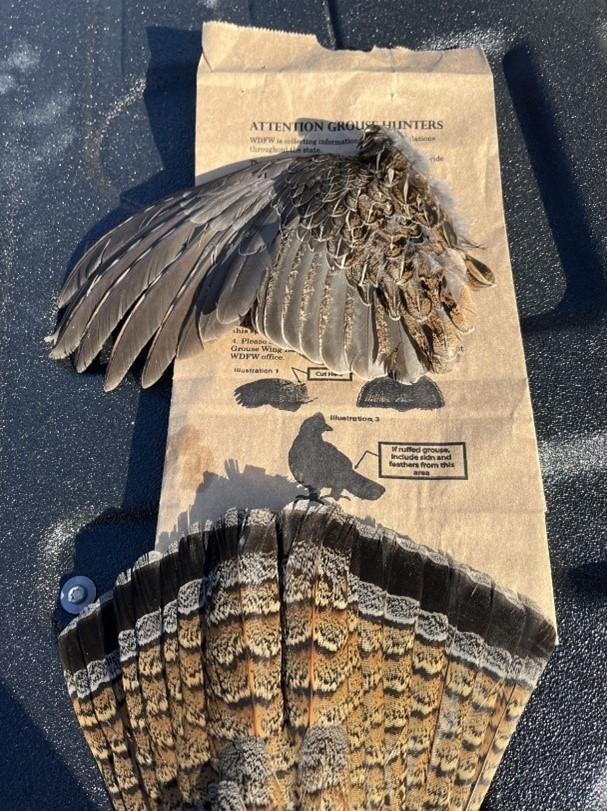
Wildlife Program report: Oct. 1-15, 2023
Managing Wildlife Populations
Grouse Collection Barrels: Biologist Brinkman checked forest grouse wing/tail barrels. A total of three samples were collected this week.
Hunters place harvested wing and tails into one of the provided paper bags and drop it into a collection barrel. The samples are collected and stored in the freezer until grouse season ends. After the hunting season, usually in February or March, biologists from across the state have a “Wing Bee” to examine samples and collect data to help inform statewide harvest metrics.

Chronic Wasting Disease (CWD): Private Lands Biologist Nizer collected a CWD sample from a successful muzzleloader hunter harvest. The sample was given to Ungulate Research Scientists Devivo.
Nizer and Natural Resource Technician Rumiser posted CWD brochures at Washington Department vendors in Whitman and Lincoln counties.
Natural Resource Technician Heitstuman checked local pits for CWD samples and collected a sample from a cow elk in the Cloverland area. Four calls from the Washington State Department of Transportation were relayed to closer employees and samples were collected for CWD testing. Heitstuman met with the Clarkston area supervisor for the Washington Department of Transportation and was informed of a possible new pit collection site.
Lake Rehab Assistance: Sherman Creek Wildlife Area Assistant Manager Palmer, Water Access Area Manager Dziekan, and Natural Resource Technician Brant assisted Fish Program staff at Williams Lake in Stevens County. Dziekan worked with the shore crew, and helped Palmer load a dump trailer with empty, washed rotenone barrels. Palmer used his mini excavator to crush the barrels, enabling them to fit the barrels in one trailer and take them to the dump.
Brant spent the day on the boat with Fish Biologist Osborne. Brant ensured the powdered piscicide was mixed with water and spread onto the lake while Osborne piloted the boat. The distribution of this rotenone was completed by noon, after which only Fish Program staff members applied liquid rotenone to the shallows.
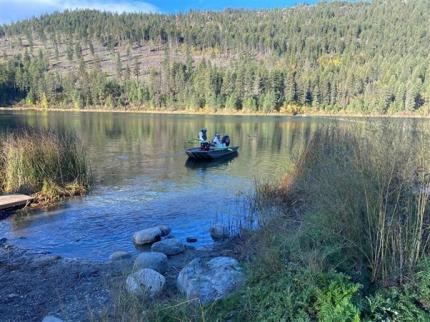
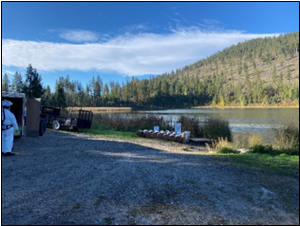
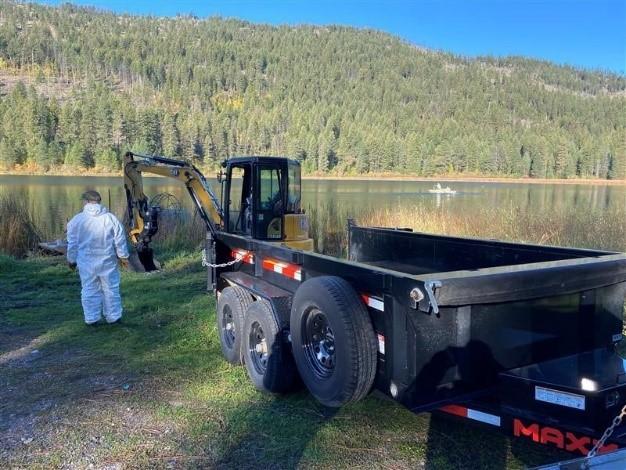
Chronic Wasting Disease (CWD) Sampling: Wildlife Conflict Specialist Samsill collected two CWD samples and submitted them for testing. Both samples came from mature does harvested with Damage Prevention Permits.
Acting Private Lands Biologist Nizer worked at a chronic wasting disease check station in Washtucna. Nizer taught four Washinton State University wildlife major students how to sample for CWD and how to educate the public. Deer were sampled at the station from Oct. 14 through Oct. 15.
Sharp-tail Grouse: Wildlife Area Assistant Manager Rimmelspacher and Wildlife Area Manager Finch did a sharp-tail grouse fall lek survey this morning to see if any resident sharp-tailed grouse males are attending the leks. If there are several birds attending the leks in the fall, trapping maybe warranted to collar a bird and use the telemetry information for winter movements.
Chronic Wasting Disease (CWD): Natural Resource Technician Tritt and Scientific Technician Moberg placed a reminder sign at the Delaney Department of Transportation pit asking staff members to let Washington State Department of Fish and Wildlife know when they drop a deer carcass off at the pit.
Wildlife Area Manager Dingman and Tritt organized sampling kits for chronic wasting disease (CWD) check stations. Dingman worked opening weekend of general deer season at the Last Resort Campground on the Tucannon and collected 37 CWD samples from hunter harvested deer. Tritt worked opening weekend of general deer season at the Asotin check station and collected 14 CWD samples from hunter harvested deer.

Providing Recreation Opportunities
Once in a Lifetime Opportunity: Wildlife Conflict Specialist Kolb assisted an out-of-state hunter with a special elk permit for game management unit (GMU) 149. Kolb spoke with a landowner who does not normally allow hunting who agreed to let the hunter onto their property. The hunter was successful and harvested a large mature bull. The hunter asked if I would pass along the following message to Washington Department of Fish and Wildlife staff members, “Please extend my sincere appreciation for this amazing opportunity that you all provided. It will be an epic memory that I’ll have for the rest of my life. Thank you!”

West Medical Lake Access Site, Grey Fire: Access Manager Dziekan talked with Greg Hayford from Washington State Department of Social and Health Services (DSHS) Medical Lake Facility. They are currently working with cleanup crews and forestry personnel falling burned trees and shrubs.
Washington State Department of Fish and Wildlife properties and facilities on West Medical Lake and Silver Lake have been affected by the fires and Hayford would like to take down some of the damaged trees. Dziekan wanted to identify the damaged trees that need to be removed and mark them with paint before approval. Dziekan identified 18 dead Ponderosa trees that need to be removed for public safety.
The DSHS Medical Lake Facility will be taking down the damaged trees at no cost to Washington State Department of Fish and Wildlife. They will have a crew fall the trees and Avista Corp will be chipping the wood and hauling it to one of their facilities in Kettle Falls.
Recreation Access Maintenance: Access staff members cleaned access sites across the district. They also hung new signage at Coues Creek and put together new ADA signage.
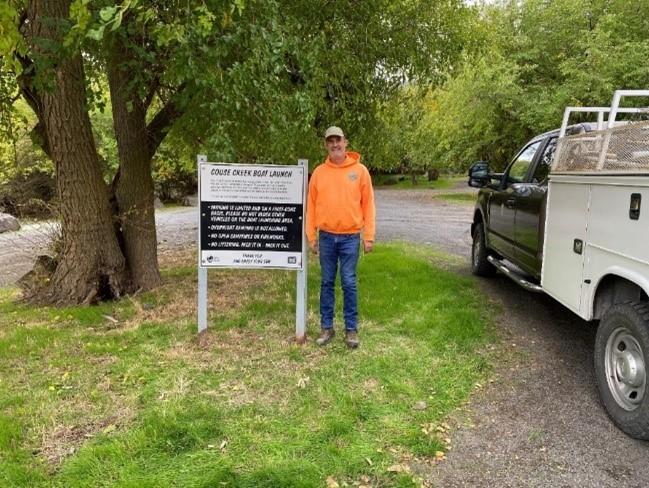
Hunter Check Stations: Biologists Lowe and Brinkman ran a hunter check station along Highway 395, north of Deer Park, to talk to hunters participating in the opening weekend of the modern firearm deer season. Biologists collected samples from hunter-harvested deer as part of a chronic wasting disease (CWD) surveillance effort in Region 1. Student volunteers from Washington State University assisted with the sampling effort both days the check station was open.
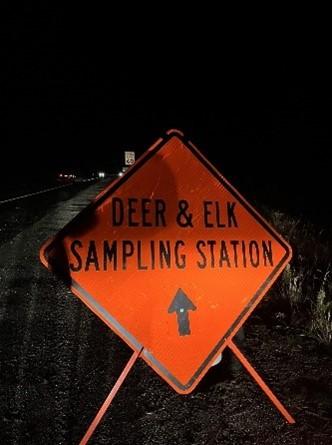
Hunter Harvest Inspection: Biologists Lowe and Brinkman checked in a mountain goat harvested from Goat Rocks West hunt area, and pinned a juvenile bighorn sheep ram that was harvested by a hunter in the Chelan Butte hunt area.
Biologists obtain measurements and take nasal swabs to test for M. Ovi (short for Mycoplasma ovipneumoniae) which is a bacterium that can be devastating to bighorn sheep populations as it can persist in healthy adults, but infection can be fatal to lambs. Additionally, they insert a pin into the horn to uniquely identify the animal and make it legal for the hunter to possess the skull.
Additionally, a bobcat was brought to the Deer Park check station and was pelt-sealed by Biologist Lowe.
Brush Clearing on Trails: Sherman Creek Wildlife Area Assistant Manager Palmer spent Tuesday through Thursday using his mini excavator to clear brush from several lengths of non-motorized trail at Rustlers Gulch Wildlife Area.
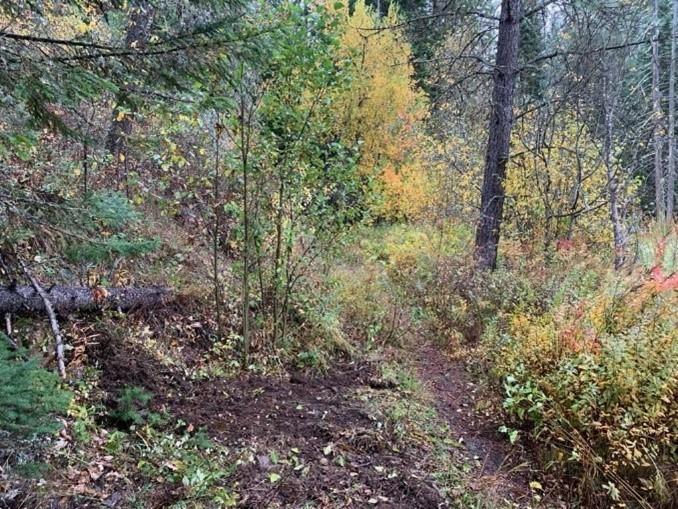

Reardan Audubon Wildlife Area: Access Manager Dziekan went to the Reardan site to work and noticed some tagging inside the restrooms on the south parcel. Dziekan walked around the restrooms and found graphic tagging on the entire backside of the restroom. Dziekan did the very best to clean up the tagging using up the last of the graffiti remover that was on the truck. Dziekan had a difficult time getting it off but between extra elbow grease and the chemical it became illegible when standing behind the restroom trying to read it.

Providing Conflict Prevention and Education
Cloverland Elk Stuck in Cattle Guard: Wildlife Conflict Specialist Wade received a call regarding a cow elk that had fallen through a cattle guard in a producer’s driveway. Wade, Private Lands Supervisor Earl, and Natural Resource Technician Heitstuman traveled to the area to evaluate the elk’s injuries and determine a plan of action to get it out of the cattle guard. After evaluation, it was determined that the best course of action was to chemically immobilize the elk and lift it out. Wade contacted District Biologist Wik who traveled to the area to immobilize the elk. Despite the best efforts of the team the elk died three days later. Wade and Natural Resource Technician Heitstuman with the assistance of the producer collected the carcass for CWD sample collection and disposal at the Asotin County Landfill.
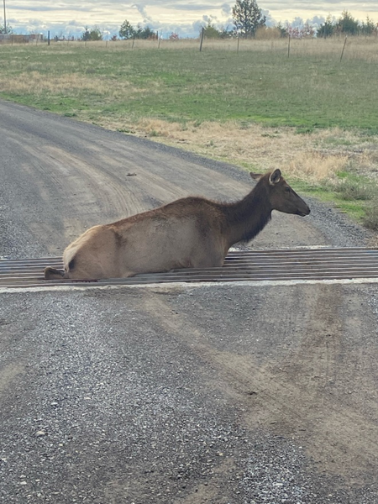
Portable Electric Fence: Wildlife Biologist Prince and Private Lands Conflict Technician Barron assisted with the installation of a portable electric fence around sheep and goats in the general area where a grizzly bear was recently photographed on a trail camera. No conflict was reported; this was a proactive measure.
Beaver Relocation: Wildlife Conflict Specialist Kolb continues to work with a permitted beaver relocator and other department staff members to determine the feasibility of relocating a conflict beaver within the Walla Walla River watershed.
Conserving Natural Landscapes
Weed Control: Natural Resource Technician Meisner worked on fall weed control. He sprayed rush skeleton weed that has gotten out of control in a remote area. The skeleton weed was most likely brought in by trespassing cattle. Lack of personnel has greatly hindered the treatment efforts.
Food Plots: Biologist Woodall spent most of a week seeding annual food plots on Smoothing Iron Ridge. It is three to four weeks behind when this task is normally complete due to personnel shortages. He will continue and hopes to finish quickly.
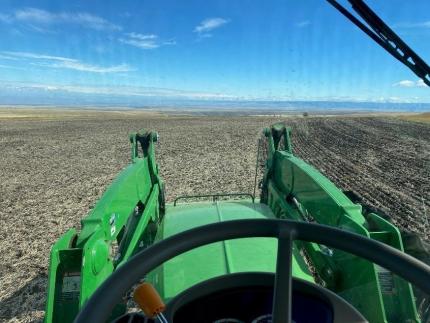

Wooten Floodplain Management Plan: Wildlife Area Manager Dingman and Natural Resource Technician Tritt completed the Year 5 monitoring of the Rainbow Lake wetland that was created during the Rainbow Lake reconfiguration project. The Year 5 monitoring report was completed and sent to the Corps.
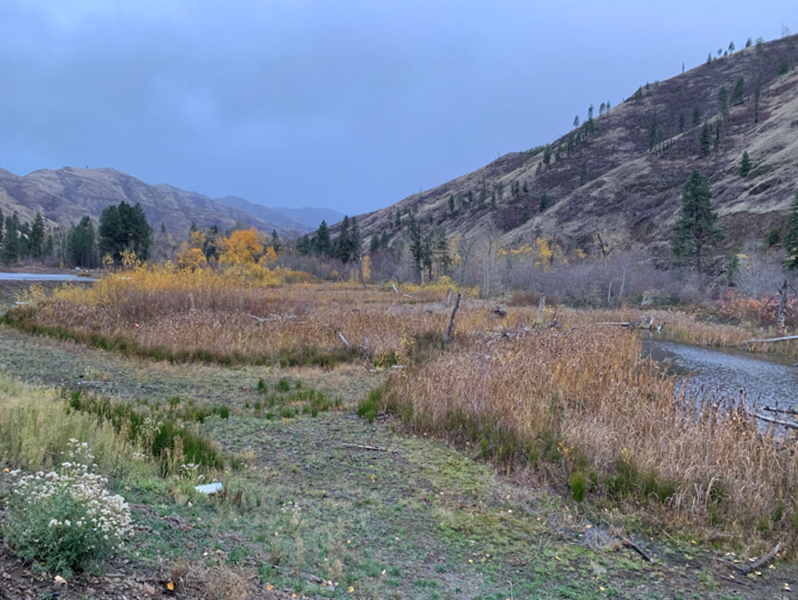
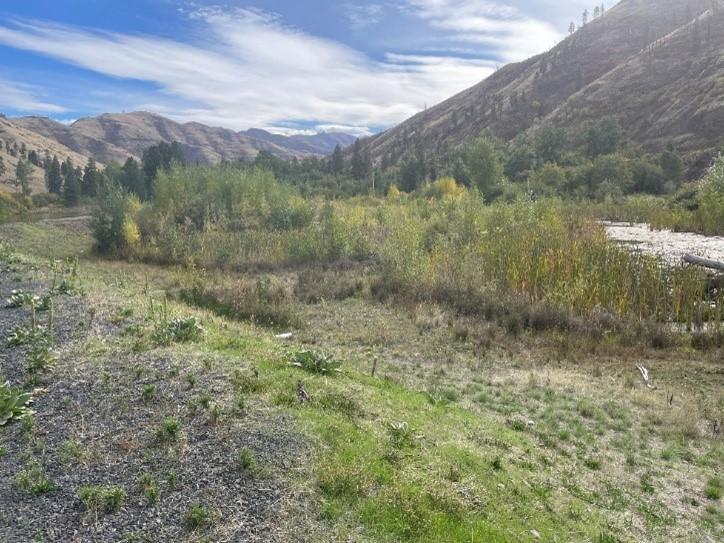
Providing Education and Outreach
Washington State University Labs: Private Lands Biologist Nizer, Ungulate Research Scientist Devivo, and Natural Resource Technician Heitstuman helped with a darting lab at Washington State University. Nizer helped train students on how to properly and safely use a dart gun on a standing deer decoy at about 35 yards.
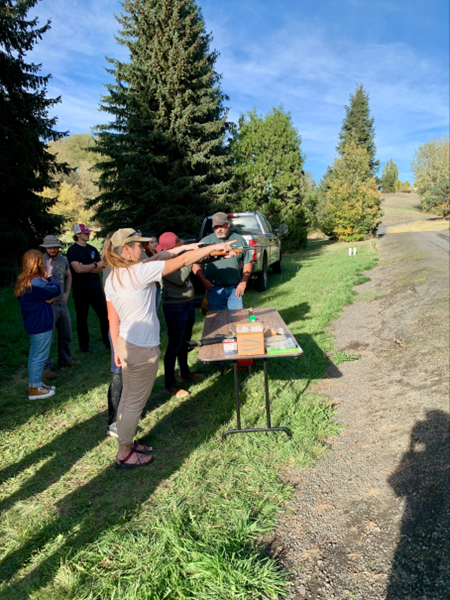
The wildlife conflict supervisor taught a wildlife trapping lab for the 29th year at Washington State University (WSU). Private Lands Biologists Earl and Nizer and Natural Resource Technician Rumiser assisted with the lab. They set up a rocket net, discussed species it can be used on, and set it off. Then they demonstrated the net gun and what it can be used for. McCanna covered the Washington Department of Fish and Wildlife’s mission, future job opportunities, wildlife professions in general, and answered all kinds of great questions. The lab was split into two days with 52 students in total.
Third Annual Chris Christensen Memorial Youth Deer Camp: Wildlife Conflict Specialist Samsill instructed and mentored seven first time deer hunters at a youth deer camp in Kettle Falls.
Managing Wildlife Populations
Mule Deer Studies: Biologists Jeffreys and Eilers teamed up with Ungulate Specialist Bundick to place 15 remote cameras on game trails in and around Blewett Pass. These cameras will be used to capture images of mule deer from the Wenatchee Mountains herd undertaking their annual eastward migration to their lower elevation winter range.
Biologists will analyze all images collected to determine age and sex of photographed deer. They will use this information to generate fawn to doe and buck to doe ratios for the herd. Biologists will compare these ratios with those obtained from aerial surveys, which are set to take place in early December. This will help determine whether remote camera placement is a viable method to assess mule deer herd composition moving forward.
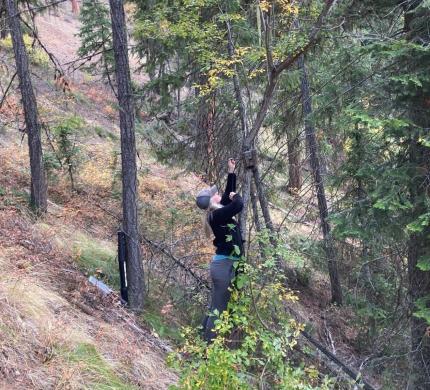
To identify the best locations for camera placement, Washington State Department of Fish and Wildlife staff members analyzed GPS data collected from does, which were collared on their winter range in the Wenatchee Foothills in 2020 and 2022. With three years of fall migration data now available biologists were able to determine, which areas along Highway 97 were used most consistently by the collared does each fall.
Additionally, Biologists Eilers and Jeffreys and Ungulate Specialist Bundick went out into the field. Parking along stretches of Highway 97, they visually searched for deer trails crossing the highway. They sought well-established, intersecting pathways through the trees and underbrush as locations where cameras were most likely to capture the greatest number of images of deer groups. Once a promising site was identified, they secured a game camera in a tree facing the trail. These cameras will be retrieved, and the photos will be analyzed in the winter after fall migration has ended.
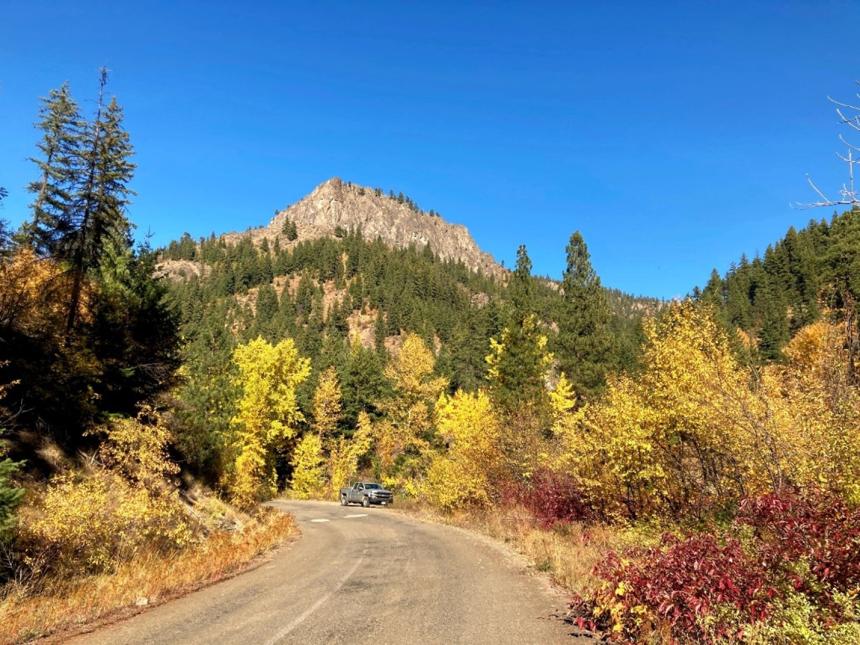
Fisher Monitoring: Wildlife Conflict Specialist Bridges and Biologists Eilers, Jeffreys, and Soltysiak teamed up to begin deploying baited camera stations for fisher monitoring in forested areas throughout Chelan County. Images collected at these baited camera traps will be used to help evaluate the effectiveness of the reintroduction of fishers back into the Cascades fisher recovery area. They will also inform future recovery actions by assessing the expansion and distribution of fishers. The idea is to draw any fishers inhabiting the vicinity into view of the game camera by placing a dispenser loaded with extremely potent skunk scent over a cow bone on a tree approximately 15 feet to 18 feet away from and in full view of the camera.
This scent lure dispenser will drip the pungent liquid on a beef bone at predetermined intervals throughout the winter. Their goal is to attract any nearby carnivores. In addition to fisher, the baited camera stations are likely to capture images of other carnivore species of concern, including gray wolf, wolverine, and lynx.
To further assess fisher occupancy and expansion, a hair snare belt is nailed to the tree right below the beef bone with the aim of snagging hairs from visiting animals climbing the tree that can then be used for DNA analysis. All data generated from these baited camera stations will be instrumental in learning more about the distribution of fishers and other carnivore species throughout the Cascade Range.
Biologists from collaborating agencies and organizations such as U.S. Forest Service and Conservation Northwest have already placed several cameras in Chelan County. District 7 staff members have now placed one in Tumwater Canyon, one off Ruby Creek Road, and one in the Grouse Mountain area. In total, District 7 Washington State Department of Fish and Wildlife staff members will deploy 20 baited camera stations before Nov. 1. These camera stations will be retrieved, and images analyzed in the spring and summer of 2024.
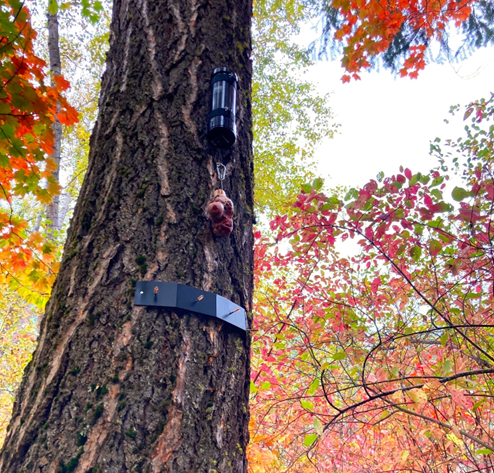
Pygmy Rabbit Enclosure Captures: At the end of each summer, the pygmy rabbit recovery team visits each breeding enclosure to ensure that there aren’t any remaining kits. Additionally, they vaccinate adults against rabbit hemorrhagic disease (RHD). Over the summer some kits were captured, but they were too small to receive a PIT tag, RHDV2 vaccine, and DNA sample. On Oct. 2, the team was joined by Washington State Department of Fish and Wildlife volunteers and Washington State University students to capture these kits. The team was successful in trapping two rabbits, both male, who appeared strong and healthy. Unfortunately, they also found a mortality. They identified it later as B4E102, a young female who was likely predated by a raptor.
On Oct. 3, the team turned their efforts to the B4 Beezley Hills enclosure. It was confirmed that all kits had been removed from the enclosure. Happily, four adults were caught and then vaccinated for RHD. One of the rabbits, adult B3E119, gave the team the slip until this capture effort. Knowing which adults are present helps Geneticist Dr. Nerkowski trace rabbit lineages.
Biologist Soltysiak set game cameras inside the B3 enclosure, along with enticing apples, to ascertain how many rabbits are inside of B3. It appears that just one rabbit now resides in the B3 enclosure. Previously, two rabbits were known to reside there.
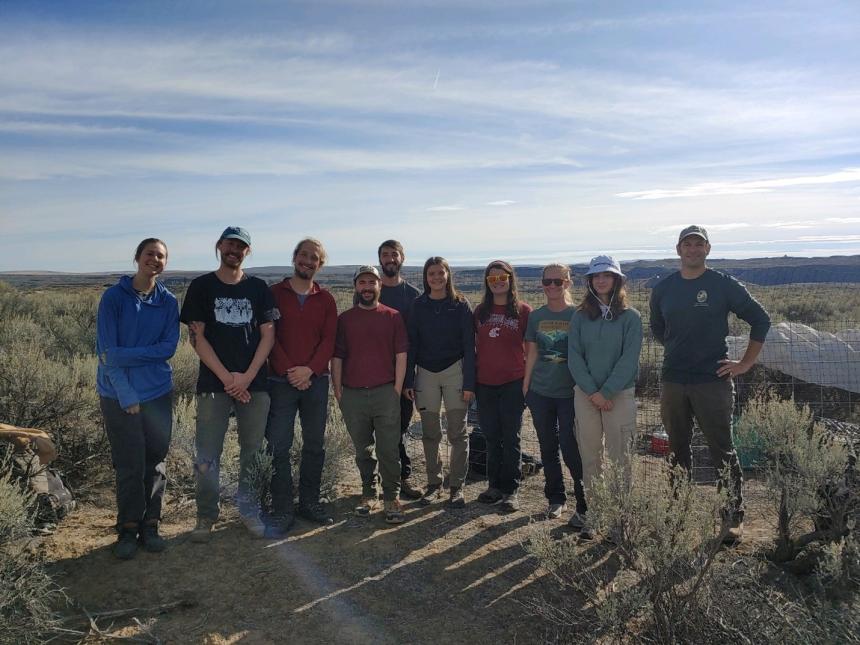
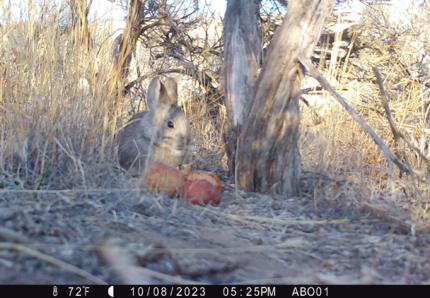
Drone Flights: Biologist Soltysiak and Data Manager Jansen flew drones over the Sagebrush Flats Wildlife Area. They tested what height drones should be flown to get the best picture of pygmy rabbit burrows from the air. An area with a high density of burrows was chosen as the test area. Drones were flown at 150, 200, 300, and 375 feet.
Flying at a lower altitude gives better picture clarity but it takes a longer amount of time. Drone batteries only last around 30 minutes. Flying the drone at a higher altitude covers more area in a shorter amount of time. The team is hoping to find the sweet spot where burrows are still easily seen in the imagery while maximizing the amount of area flown in a single session.

Department of Natural Resources Collaborations: A few weeks ago, the Methow Wildlife Area hosted a tour with about ten Department of Natural Resources (DNR) employees to look at some future collaborative projects. For example, the Methow Wildlife Area plans to conduct forest thinning and prescribed burning treatments at various locations. Our projects neighbor quite a few private property parcels and some of the neighbors have expressed interest in simultaneously treating their forests.
DNR brought a diverse group of staff members to look at the feasibility of collaborating with Washington Department of Fish and Wildlife (WDFW) and the private property owners. This cross-agency collaboration is still in the early phases of development, but both DNR and WDFW are committed to helping our neighbors maintain healthy and resilient forests in the Methow Valley.
Hazard Trees: General deer season kicks off this weekend. It is one of our busiest times of the year and our campgrounds and primitive camping areas receive very high visitor use. To ensure our visitors have a safe and enjoyable hunting season, Methow Wildlife Area staff members have been diligent about assessing and removing hazardous trees from popular camping areas. Several dead snags have been mitigated at Bobcat, Beaver Creek, Cougar Lake, and Bear Creek campgrounds.
Washington Conservation Crew: Recently, a Washington Conservation Crew (WCC) spent a week performing some much-needed fence maintenance. This fence project is intended to keep neighboring cattle from entering the wildlife area and engaging in unauthorized grazing in the post fire recovery Cub Creek 2 burn scar area. The crew will be back in early November. Weather permitting, they hope to build a wildlife friendly buck and rail fence along a small section of Beaver Creek.
This fence borders a campground and is intended to protect endangered fish by keeping livestock out of the creek while still allowing safe passage for a wide array of wildlife. Buck and rail fences are the preferred fence in campgrounds since they are built completely out of wood and are safer for children and families camping in the area. They are also more aesthetically pleasing than wire fencing.
Big Buck Fencing: The Methow Wildlife Area has received numerous reports about unauthorized cattle in the Big Buck Unit. The cows have trickled over from a neighboring private property grazing allotment and broke down a sizable stretch of fencing around Deadhorse Lake. The livestock owner was contacted and is working diligently to find and round up all of the cattle. Additionally, Methow Wildlife Area staff members spent the better part of a day repairing the riparian exclusion fencing to try and keep cattle out of the lake.
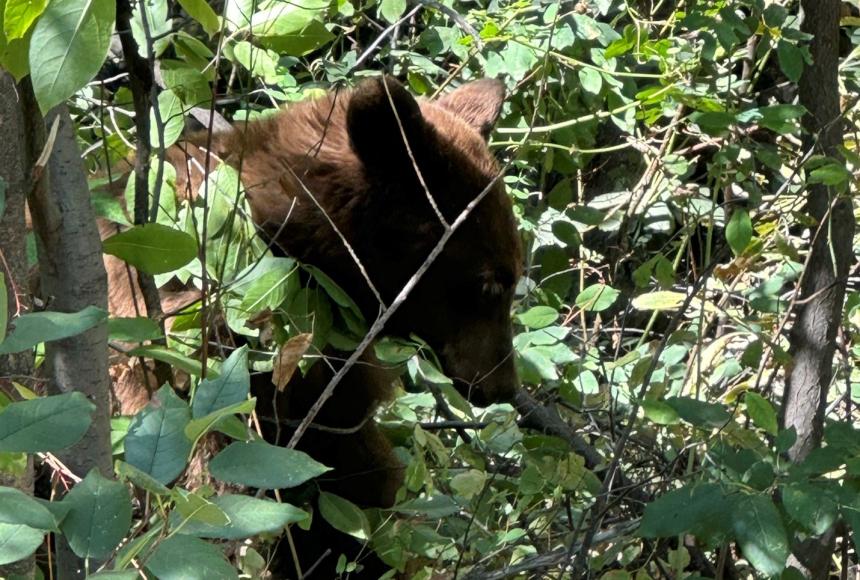
Providing Recreation Opportunities
National Hunting and Fishing Day: A few weeks ago, Methow Wildlife Area Manager Troyer ventured over to Region 1 in eastern Washington to help at the National Hunting and Fishing Day event. This event was held at Diamond Lake near Newport.
The event was very well attended with several hundred youth taking part in the festivities. There were tons of activities for kids and families to choose from. The activities included an archery range, air rifle range, and trout fishing. Troyer got to work with various volunteers and Region 1 staff members at a very busy fishing dock where hundreds of trout were stocked in net pens for the kids to catch.
From the time the event started at 9 a.m. until it ended at 3 p.m. the dock was full of kids catching fish. Countless hooks were baited, and tons of fish were caught. For many kids, this was the first time they ever fished. Luckily, the fish were biting. Every child that wanted to catch a fish was successful.
There was also a fish cleaning station so the kids could take their catch home with them. If they didn’t want to take their fish home, it was donated to a local foodbank. Overall, it was an excellent event coordinated by our Region 1 colleagues. It was an excellent way to get kids involved in hunting and fishing.
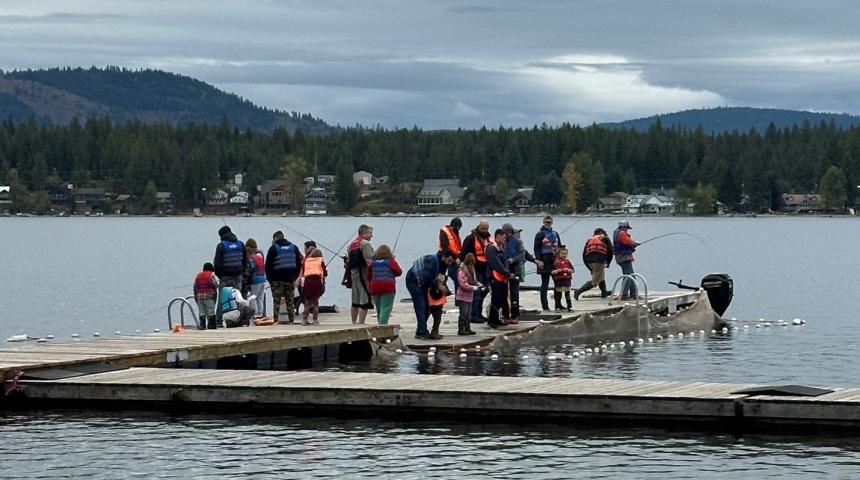
Conserving Natural Landscapes
Scotch Creek Riparian Restoration Project: Staff members wove four new beaver dam analogs with weave material collected off the Chopaka Unit and planted 100 water birch within the enclosure that was constructed the previous week. Water birch is an important food source for sharp-tail grouse in the winter when snow depths prohibit them from accessing the vegetation.
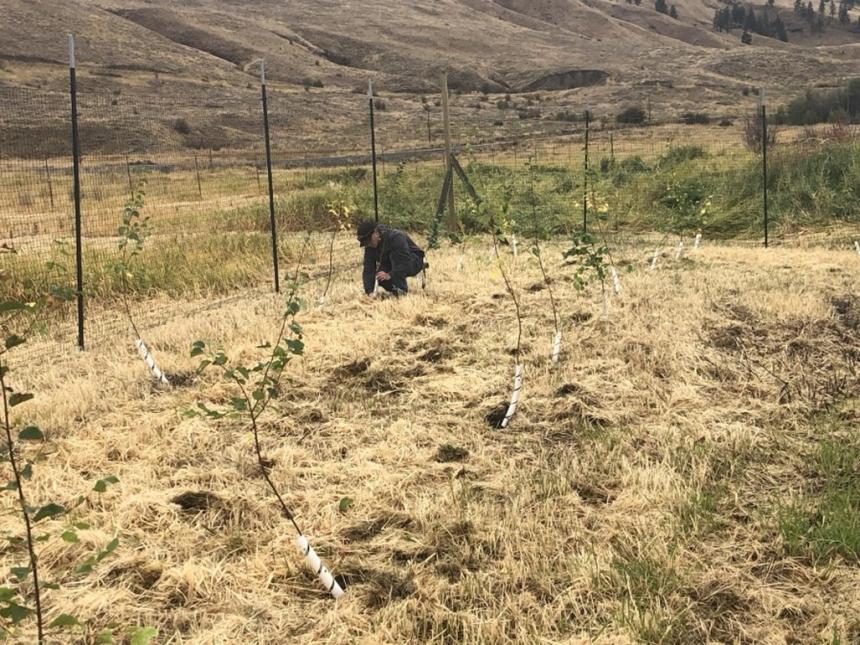
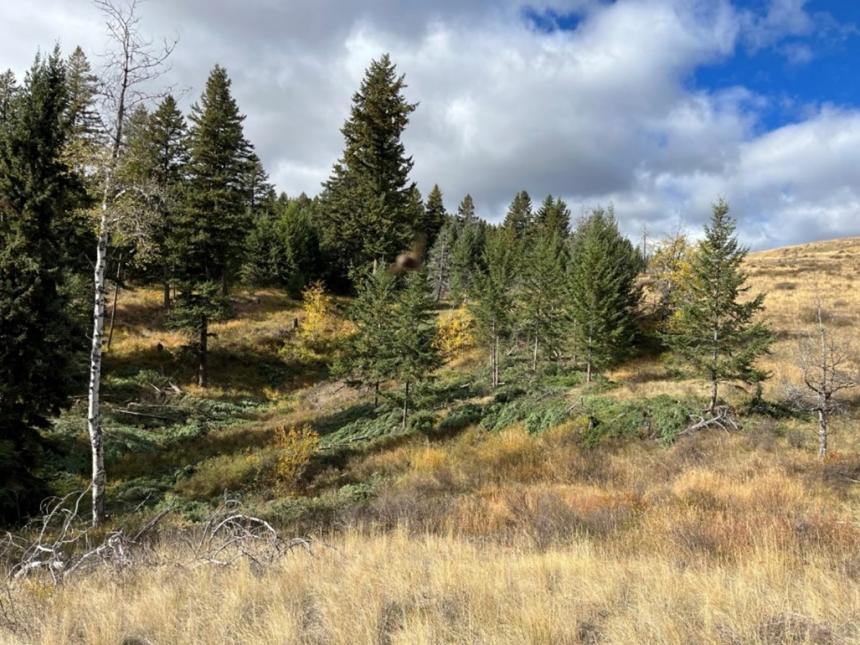
Proposed Winter Range Closure: The Methow Wildlife Area is still conducting outreach, fielding a wide range of phone calls and emails, and collecting survey input related to the proposed winter range closure.
The survey is open until Oct. 15. To learn more about the proposed closure to protect mule deer, please view the News Release. Towards the top of the news release is a yellow box that contains some useful documents such as maps and a fact sheet. Please feel free to contact us if you want to learn more. Your input is valuable and appreciated.
Managing Wildlife Populations
Dead Columbia River Bull Elk: District 4 Wildlife Conflict Specialist Hand, Scientific Technician Werlau, and Detachment 33 enforcement responded to a very large bull elk that died and washed up on a gravel bar in the Columbia River near Hanford. They were unable to confirm why the elk died because the only injury observed was a broken front tine on one of his antlers. The antlers were removed.
Modern Firearm General Deer Opener: District 4 Wildlife Conflict Specialist Hand patrolled game management unit (GMU) 372 for the opener of the modern general deer season. Hunting pressure appeared to be up from past years. Hand made several contacts with hunters. No deer were checked, although most hunters reported seeing deer, mostly antlerless or non-legal bucks.
Bighorn Sheep Survey: Natural Resource Technician Blore and Natural Resource Scientist Nass aided in bighorn sheep surveys on the Cleman Mountain and Yakima Canyon herds.
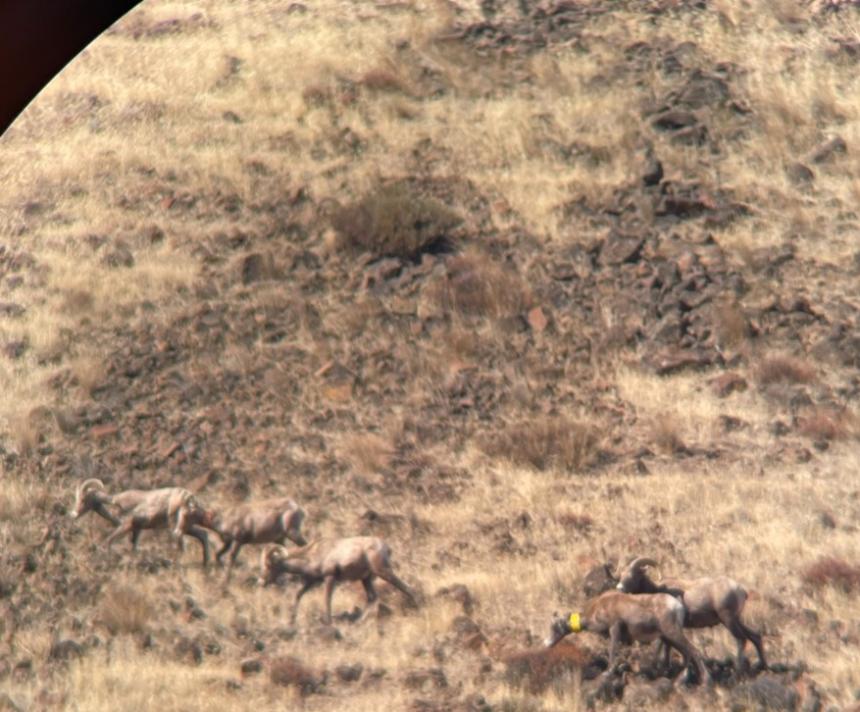
Yakima Canyon Sheep Survey: District 4 Wildlife Biologist Fidorra joined other Region 3 staff members on a land-based survey of the Yakima Canyon bighorn population. Several groups surveyed side-canyons for sheep to estimate age and sex classes. This work was conducted as part of monitoring success of management actions aimed at reducing long term herd impacts from MOVI (Mycoplasma ovipneumoniae), a respiratory bacterium often fatal to bighorn sheep. Several groups were counted on a perfect weather day in the canyon.
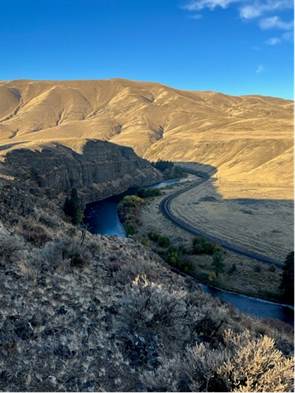

Oak Creek Wildlife Area Bighorn Sheep Survey: Oak Creek Wildlife Area Assistant Manager Charlet and Natural Resource Technician Boggs assisted with a bighorn sheep survey on the Yakima Canyon herds.
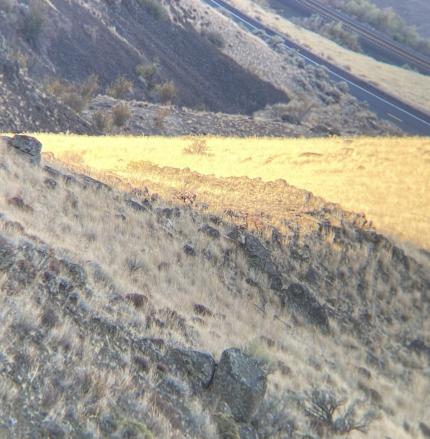
Providing Recreation Opportunities
L.T. Murray Wildlife Area Trails: LT Murray Wildlife Area Manager Morrison and National Motorcycle Association President Toenyan reviewed a proposed single-track trail reroute along the south fork of Manashtash Creek. The original trail is very old, degraded, and is currently contributing to bank erosion and sediment loading into the creek.

Colockum Headquarters Parking Lot Improvements: Colockum Wildlife Area staff members finished up improvements to the headquarters parking lot with the installation of heavy duty, 1700 lb. picnic tables. These tables were chosen for their resistance to vandalism and theft.

Windmill Ranch Field Hunting: Corn harvest in the Windmill Ranch Unit of the Sunnyside/Snake River Wildlife Area has opened up fields for waterfowl hunting. Small sections of standing corn were strategically left to provide cover for field hunters.
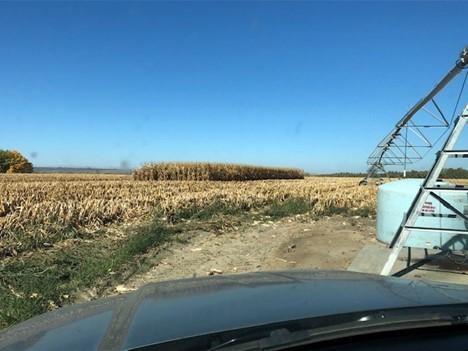
Providing Conflict Prevention and Education
Rattlesnake Hills Elk: District 4 Wildlife Conflict Specialist Hand monitored elk activity and assisted damage permit holders with hunt coordination. Additional damage permits were issued and delivered to one landowner. Trail cameras were maintained along heavily used trails near the Hanford boundary.
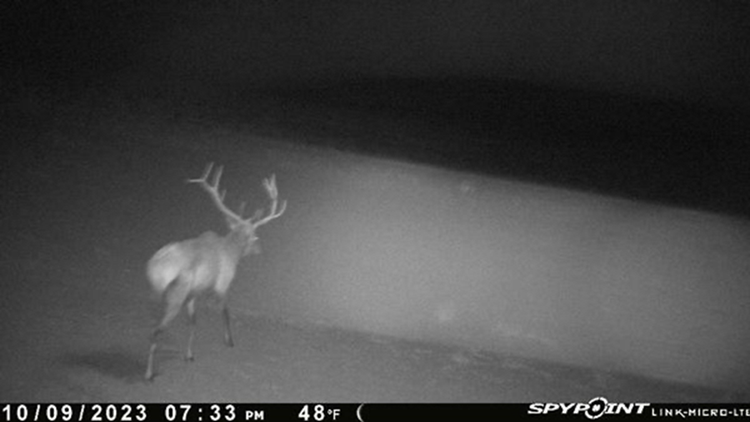
Plymouth/Paterson Area Deer Damage: District 4 Wildlife Conflict Specialist Hand monitored deer activity at a wine grape vineyard that was receiving substantial browsing from deer. In addition, damage permits were developed and issued to assist a neighboring large farm with row crops, orchard, and vineyards to address deer damage impacts. Five youth hunters from the Horse Heaven Hills special permit hunt were contacted and offered hunting opportunities at the farm during the general deer season.
West Richland Deer: District 4 Wildlife Conflict Specialist Hand continued to coordinate with an owner of several small corn fields that have been damaged by deer near the Yakima River. Three additional Master Hunters have been deployed from the Region 3 list and two were successful in removing a deer.
Kahlotus Deer Damage: District 4 Wildlife Conflict Specialist Hand prepared Damage Prevention Permits for several landowners in the Kahlotus area. These permits, as well as youth and Master Hunter deployments will be used to haze deer out of winter wheat crops in GMU 381 along the Snake River. The permits will be dispersed to landowners after general deer season concludes.
Possible Finley Cougar Complaint: District 4 Wildlife Conflict Specialist Hand and Detachment 33 enforcement responded to a call concerning a possible cougar that scared some horses through a fence in the Finley area. The area was canvassed, and no signs of cougar presence or activity was determined. Some evidence of coyote or domestic dog digging was observed, and the owner will be installing trail cameras for continued monitoring.
Conserving Natural Landscapes
Shrubsteppe Conservation through Land Protection: District 4 Wildlife Biologist Fidorra joined a team from the regional office to speak to the seller’s agents and tour a large property that holds strategic value for shrubsteppe conservation. They have a long way to go to determine if acquisition could be a potential outcome. Partners and potential buyers would be needed to help secure funding. The property is valuable for ferruginous hawk, ground squirrels, burrowing owls, and other shrubsteppe species and holds great recreation potential for the public.
L.T. Murray Weed Control: Natural Resource Technician Blore continued spraying weeds on the L.T. Murray Wildlife Area including Himalayan blackberry.
Prescribed Burn at Oak Creek: LT Murray Wildlife Area Manager Morrison, Natural Resource Technician Blore, and Natural Resource Scientist Nass, and Prescribed Fire Program Manager Eberlein shuttled vehicles and equipment to a prescribe burn location on the Oak Creek Wildlife Area.
L.T. Murray Vantage Highway Fire Restoration: The L.T. Murray crew took a delivery of around 3,000 sagebrush and rabbitbrush plugs that will be planted this fall on the Whiskey Dick Unit portion of the 2022 Vantage Highway fire area.
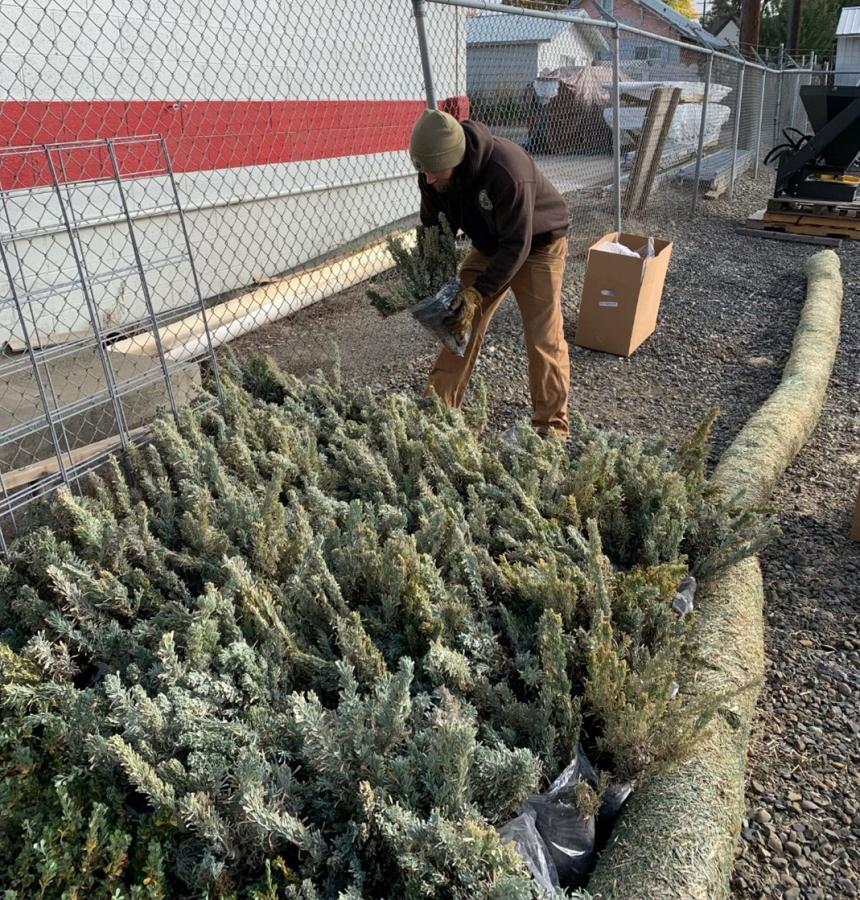
Colockum Cattleguard Installation: Colockum staff members facilitated the installation of two new cattleguards on Ingersoll Road. The existing cattleguards were damaged during a Washington State Department of Fish and Wildlife timber thinning project. New cattleguards needed to be installed to restrict livestock from the adjacent Department of Natural Resources grazing allotment.

Bailie Youth Ranch Mowing: Sunnyside/Snake River Wildlife Area Manager Kaelber used the marsh master to mow ponds in the Bailie Youth Ranch Unit. Mowing greatly improved wetland conditions by providing more open water for waterfowl, as well as improved waterfowl hunting conditions near the fence post blind.
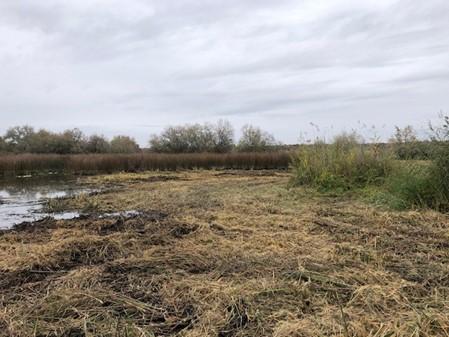
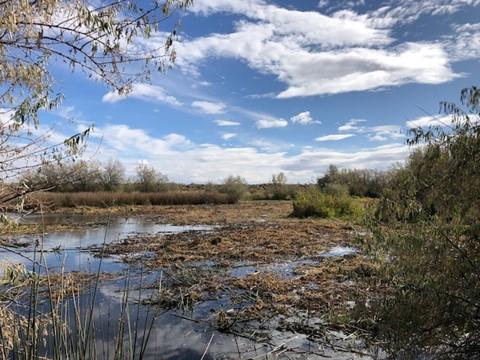
Mesa Lake Mowing: Sunnyside/Snake River Wildlife Area Manager Kaelber and Assistant Manager Jahns mowed portions of the 7-acre pond in the Mesa Lake Unit. The area had dense stands of cattails and phragmites prior to mowing.
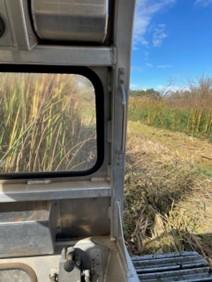
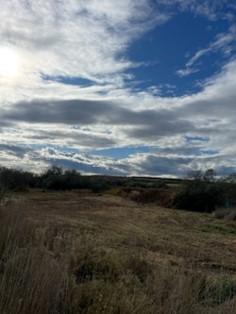
Wenas Wildlife Area—Hoover Wire Removal: Wenas Wildlife Area staff members rolled and removed almost 4,000 pounds of barbed wire from the Hoover portion of the wildlife area. The wire was both hand-rolled and rolled using the wire roller built by Wenas Wildlife Area staff members. The wire was taken to Pacific Steel to be recycled.

Wenas Wildlife Area—Black Canyon Planting: Wenas Wildlife Area Habitat Specialist Miller and Natural Resource Technician Stoltenow planted plugs of native species around the water trough in Black Canyon. This area was burned in the Evan’s Canyon fire. The species planted included quaking aspen, Woods rose, ocean spray, and Douglas hawthorn.
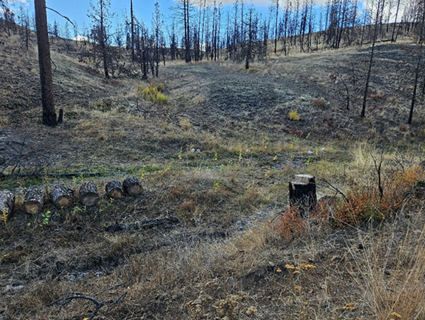
Wenas Wildlife Area—Water Troughs: Wenas Wildlife Area Natural Resource Technician Stoltenow, Habitat Specialist Miller, and Natural Resource Specialist Frame replaced old water troughs in Ladybug and Little Pine canyons with new troughs and plumbing at existing spring sites. Both canyons showed a lot of signs of wildlife use and the troughs will likely be well used by wildlife. In addition, Wenas Wildlife Area staff members scouted more canyons in the wildlife area for potential future trough replacement projects.
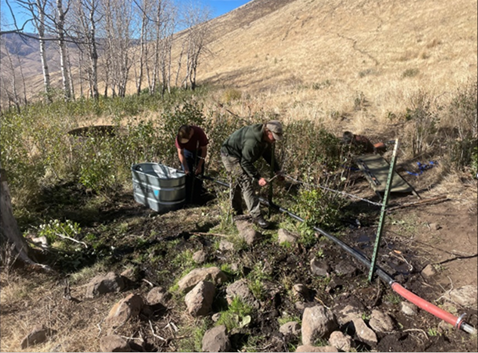

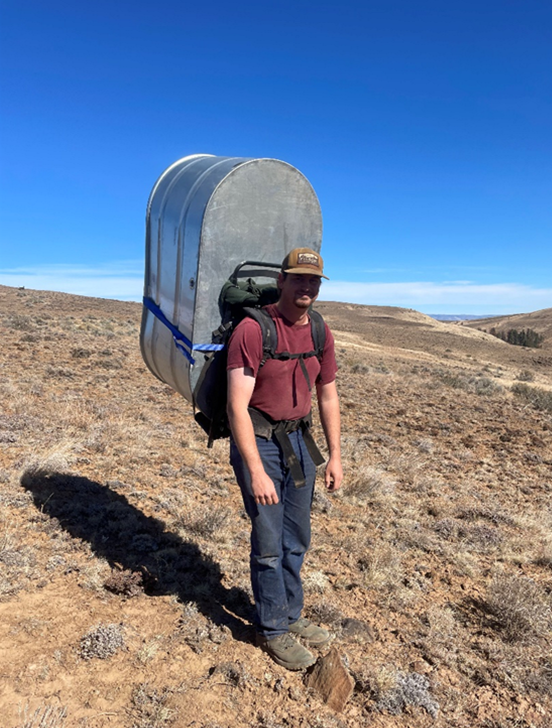
Providing Education and Outreach
Safari Club International Pronghorn Presentation: District 4 Wildlife Biologist Fidorra was invited to give an update on pronghorn to Safari Club International at an event in Yakima. The event was a joint meeting of the Yakima and Tri-Cities chapters. Fidorra gave an update on pronghorn numbers, pronghorn distribution, and WDFW-Yakama Surveys. The event was a success and recruited new volunteers for Washington Department of Fish and Wildlife surveys and made new connections with the local non-profit organization who assisted the Yakama Tribe with the first successful reintroductions of pronghorn in Washington.
Oak Creek Wildlife Area School District Outreach: Oak Creek Wildlife Area staff members coordinated with a local high school to have old elk feeding signage redesigned and constructed by local students. Staff members also worked to coordinate volunteer opportunities for local high school seniors.
Other
Oak Creek Wildlife Area Elk Fence: Oak Creek Wildlife Area Natural Resource Technician Boggs begins maintenance on the elk fence at the headquarters manager residence. Boggs also rechecked various sections of the Oak Creek Unit elk fence. He ensured elk were unable to pass through any holes or downed fencing.
Managing Wildlife Populations
Hunter Harvest Wildlife Checks: Regional wildlife biologists, wildlife conflict specialists, and customer service specialists continue to check hunter harvested wildlife. Many species of wildlife including cougars, bobcats, bears, big-horned sheep, and mountain goats have various checking requirements to facilitate biological sample collection and assure the legality of harvests. Hunters are reminded to check the Big Game Seasons Pamphlet in order to be clear on checking requirements for various species. Recently, Biologist Holman checked two big-horned sheep harvested by happy hunters in WDFW’s Region 1.
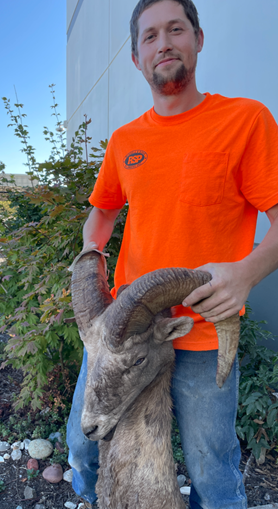

Treponeme-Associated Hoof Disease (TAHD) Hoof Collection: Wildlife Conflict Specialist Aubrey was contacted by a district biologist in Region 6 about a fresh set of elk hooves suspected to be infected with TAHD. Wildlife Conflict Specialist Aubrey was able to meet the hunter and transport the hooves to a specialized freezer to assist with Washington State University's ongoing research.
Wolf Telemetry: Wildlife Conflict Specialist Jacobsen accompanied Wolf Biologist Spence for a day in the field, checking wolf radio collar signals, and looking for tracks in the South Cascades.
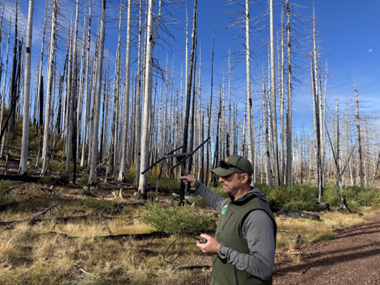
Providing Recreation Opportunities
Access Program Site Maintenance: Private Lands Biologist Gray replaced old, weathered program signage at properties enrolled in the Private Lands Access Program in Skamania County. The current federal Voluntary Public Access Program Grant awarded to Washington Department of Fish and Wildlife in 2020 helps support the purchase and replacement of deteriorated signage.

Providing Conflict Prevention and Education
District 9 Depredation Investigation: Wildlife Conflict Specialist Jacobsen, Biologist Spence, and Officer Nelson investigated a cow carcass found on a grazing allotment on U. S. Forest Service land. The livestock producer accompanied Washington Department of Fish and Wildlife staff members during the investigation. The carcass was several weeks old and heavily scavenged, which hindered the investigation. The cause of death for this cow was classified as “unknown cause of death.”
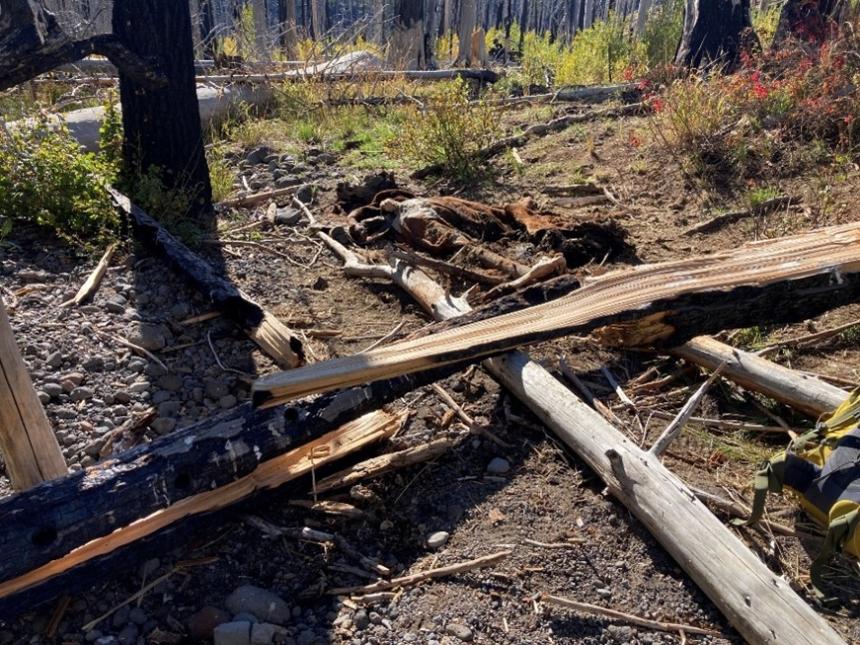
Bear in Yard: A Clark County landowner contacted Washington Department of Fish and Wildlife (WDFW) regarding a black bear that was captured by a trail camera in their yard. Wildlife Conflict Specialist Jacobsen spoke with the reporting party about the bear. It appeared to have a WDFW ear tag from a previous human food habituation issue. Jacobsen will continue to monitor reports in the area.

Cougar in Driveway: Wildlife Conflict Specialist Jacobsen was contacted by a resident in an urban area regarding a cougar that was photographed in her neighbor’s driveway earlier that morning. Jacobsen patrolled the area but was unable to locate the cougar.
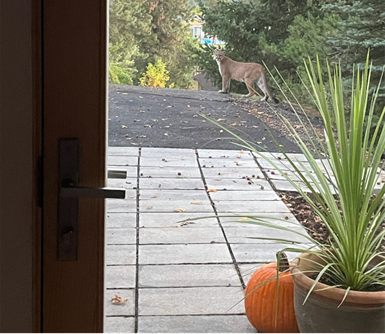
District 9 Injured Deer Reports: Wildlife Conflict Specialist Jacobsen responded to a report of an injured deer in Skamania County. The deer had been struck by a vehicle and then later attacked by what appeared to be a domestic dog. Jacobsen euthanized the deer and donated the carcass to a neighboring landowner.

Wildlife Conflict Specialist Jacobsen and Officer Bolton responded to a report of an injured deer that had been trapped in an empty cattle water trough for two days. It took the landowner two days to realize where the thumping sound was coming from before she discovered the deer. The landowner dumped the deer out of the trough and turned the trough upside-down to keep other deer from jumping in. After giving the small deer a day to recover, the deer was still not able to stand up after the ordeal. Jacobsen eventually had to euthanize the deer.
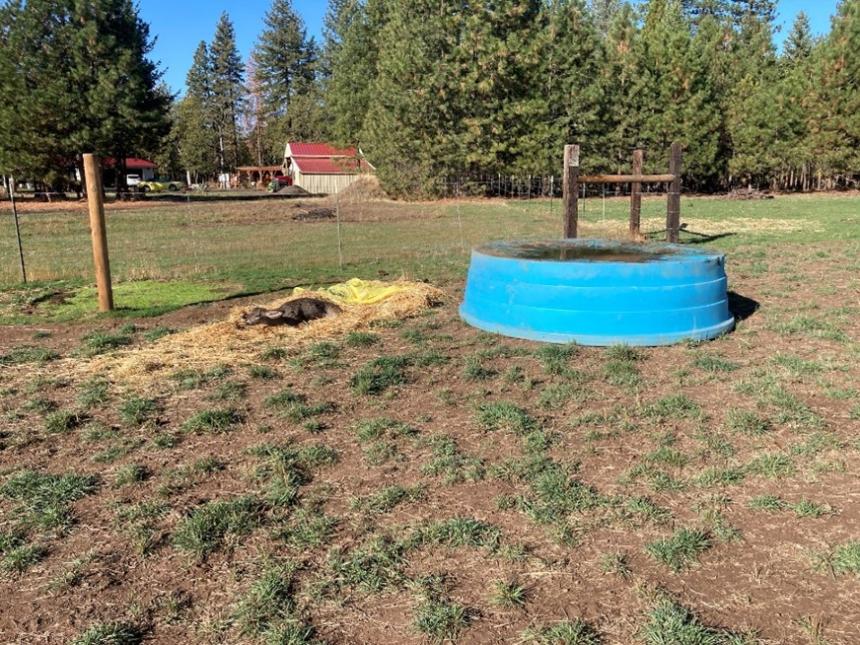
Damage Prevention Cooperative Agreements: Wildlife Conflict Specialist Jacobsen met with several commercial agriculture producers to initiate or renew Damage Prevention Cooperative Agreements. These agreements help Washington Department of Fish and Wildlife and producers mitigate crop damage and loss due to deer and elk.
District 10 Cougar Depredation: Wildlife Conflict Specialist Aubrey responded to a report of three sheep killed by a cougar. This was in the same area and the same livestock owner who had a single sheep killed ten days earlier in a different pasture. The depredation happened midday, but unfortunately took over 24 hours to be reported. A depredation investigation was conducted, and it was determined that the cause of death was a cougar. Given the circumstances, hounds were deployed in an attempt to remove the cougar. The hounds were unable to strike on a scent. Trail cameras were left to monitor the situation and livestock husbandry advice was given.
District 10 Injured Deer and Elk Reports: Wildlife Conflict Specialist Aubrey responded to a report of a deer with an arrow in its front shoulder. The deer was still mobile and was not located by Aubrey. The deer will likely be able to survive the injury based on the description from the original reporting party.
Wildlife Conflict Specialist Aubrey responded to a report of a young deer that had been down in a homeowner’s yard for about eight hours. The deer was unable to stand and appeared to be experiencing regular seizures. Aubrey euthanized the deer.
Wildlife Conflict Specialist Aubrey responded to a report of a deer hit by a vehicle. Unfortunately, the injuries were severe, and the deer was euthanized.
Wildlife Conflict Specialist Aubrey responded to an elk down in a field. The reporting party was unsure if the elk had been hit by a vehicle or if it was suffering from TAHD. Upon arrival, it was clear the elk was hit by a vehicle. The elk was euthanized and donated to an individual who wanted to salvage the animal.
Conserving Natural Landscapes
Opening Weekend of Modern Firearm Deer Season on the Klickitat Wildlife Area: Assistant Regional Wildlife Program Manager Hauswald and Klickitat Wildlife Area Manager VanLeuven conducted a hunter success survey on the Soda Springs Unit on Saturday Oct. 14. The number of camps on the wildlife area was noticeably lower than normal, with several good camping spots vacant.
Hunters reported seeing a few does and bucks, but not as many deer as expected. Most of the hunters contacted were people who hunt the Klickitat Wildlife Area every year. Of 67 deer hunters counted, only one harvested a deer (a 3-point buck) on opening day. Manager VanLeuven worked solo on Oct. 15, contacting 38 hunters. None had harvested deer, however there was a report of a youth hunter harvesting a 2-point buck. The weather was pleasant and the hunters camping on the Klickitat Wildlife Area seemed to be enjoying their time. Quite a few hunters left early due to the low number of deer observed.